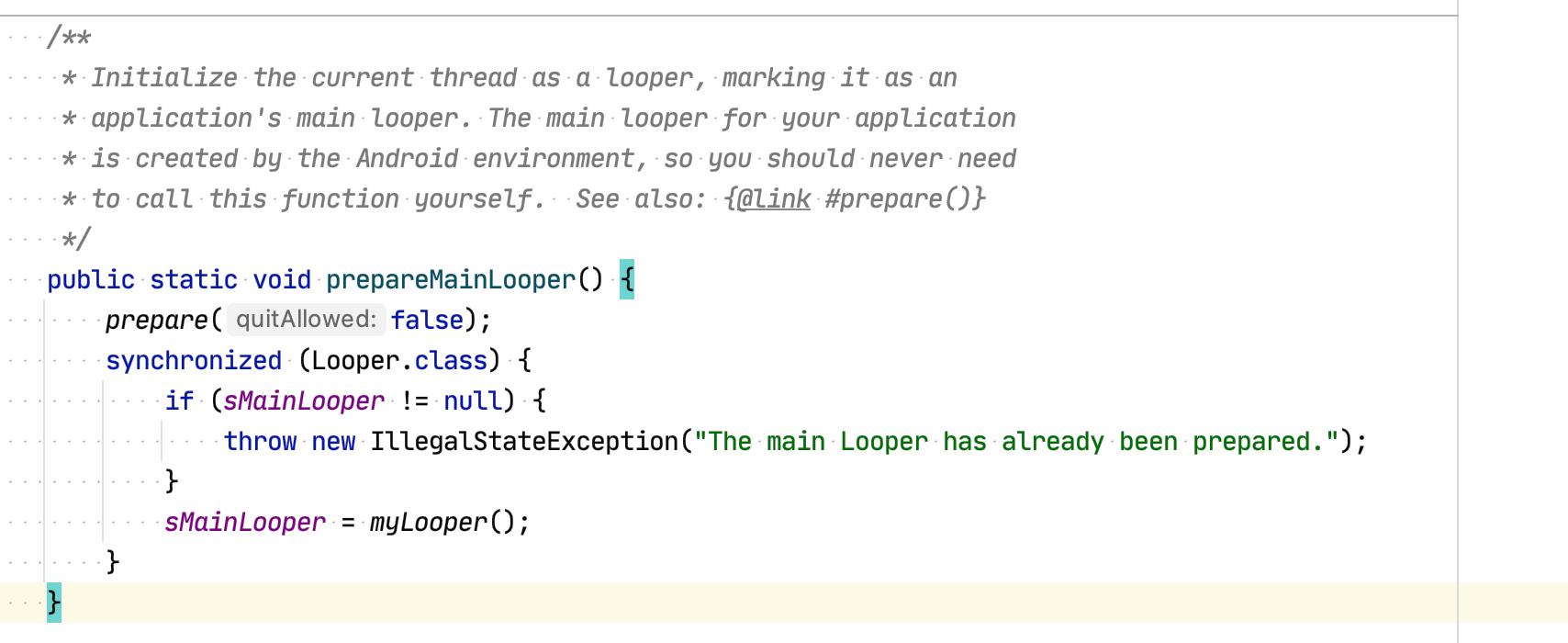Handler机制
Posted 無昂博奥
tags:
篇首语:本文由小常识网(cha138.com)小编为大家整理,主要介绍了Handler机制相关的知识,希望对你有一定的参考价值。
源码位置
android-rk3399/frameworks/base/core/java/android/os/Handler.java
Handler构造函数
在新建Handler时,在调用Hander重载函数,源码如下:
public Handler(Callback callback, boolean async)
if (FIND_POTENTIAL_LEAKS)
final Class<? extends Handler> klass = getClass();
if ((klass.isAnonymousClass() || klass.isMemberClass() || klass.isLocalClass()) &&
(klass.getModifiers() & Modifier.STATIC) == 0)
Log.w(TAG, "The following Handler class should be static or leaks might occur: " +
klass.getCanonicalName());
//通过threadLocal.get获取当前线程的Looper对象
mLooper = Looper.myLooper();
if (mLooper == null)
throw new RuntimeException(
"Can't create handler inside thread that has not called Looper.prepare()");
//获取MessageQueue对象
mQueue = mLooper.mQueue;
mCallback = callback;
mAsynchronous = async;
Handler是如何和MessageQueue联系起来的?
通过Handler构造函数中的业务逻辑,可以看出先获取looper对象,然后获取looper对象中的MessageQueue对象,这样做的目的是在当前线程中维护一个MessageQueue对象。
sendMessage函数
使用此函数来发送消息,将消息放到MessageQueue的队尾。发送的消息将在handleMessage函数中接收
public final boolean sendMessage(Message msg)
return sendMessageDelayed(msg, 0);
sendEmptyMessage函数
此函数用来发送只包含what值的消息。使用场景:当不需要传数据时,可以通过此函数发送一个what值,然后在handleMessage中判断message的what值来执行自己的业务逻辑。
/**
* Sends a Message containing only the what value.
*
* @return Returns true if the message was successfully placed in to the
* message queue. Returns false on failure, usually because the
* looper processing the message queue is exiting.
*/
public final boolean sendEmptyMessage(int what)
return sendEmptyMessageDelayed(what, 0);
enqueueMessage函数
handler中的所有send开头的发送消息都会最终执行到enqueueMessage函数。
private boolean enqueueMessage(MessageQueue queue, Message msg, long uptimeMillis)
msg.target = this;
if (mAsynchronous)
msg.setAsynchronous(true);
//调用messagequeue对象的enqueueMessage函数
return queue.enqueueMessage(msg, uptimeMillis);
handleMessage函数
子类必须实现此函数来接收消息。也就在我们使用handler时需要在此函数中实现接收消息的业务逻辑。
/**
* Subclasses must implement this to receive messages.
*/
public void handleMessage(Message msg)
至此handler的源码分析完毕,里面还有一些其它的函数,在此没有做说明。
Looper
源码位置
Looper.java源码路径为:
android-rk3399/frameworks/base/core/java/android/os/Looper.java
prepare()函数
通过prepare函数可以得知,在一个线程中只会存在一个Looper对象。当多次调用prepare函数时会抛出以下异常。
private static void prepare(boolean quitAllowed)
if (sThreadLocal.get() != null) //通过prepare函数可以知道一个线程中只能存在一个Looper对象,否则会抛出以下异常
throw new RuntimeException("Only one Looper may be created per thread");
//通过ThreadLocal存放一个Looper对象
sThreadLocal.set(new Looper(quitAllowed));
在主线程中,调用的是prepareMainLooper函数。

我们之所以在activity中不调用prepare()函数就可以直接使用Handler,是因为ActivityThread类的main函数已经帮我们间接调用了prepare函数。ActivityThread的main函数如下图:

Looper()构造函数
在Looper的构造函数中创建一个MessageQueue对象,并获取当前线程对象。源码如下:
private Looper(boolean quitAllowed)
mQueue = new MessageQueue(quitAllowed);
mThread = Thread.currentThread();
Loop()函数
Looper通过loop()函数中的死循环不断的从MessageQueue中获取Message,然后调用message.target也就是Handler来调度信息。
public static void loop()
/**
* public static @Nullable Looper myLooper()
* return sThreadLocal.get();
*
* 通过myLooper()函数来获取Looper对象。
*/
final Looper me = myLooper();
if (me == null)
throw new RuntimeException("No Looper; Looper.prepare() wasn't called on this thread.");
final MessageQueue queue = me.mQueue;
//...此处省去多余代码
for (;;)
Message msg = queue.next(); // might block
if (msg == null)
// No message indicates that the message queue is quitting.
return;
//...此处省去多余代码
try
//通过msg.target获取Handler对象,然后通过handler对象来调度信息
msg.target.dispatchMessage(msg);
finally
if (traceTag != 0)
Trace.traceEnd(traceTag);
//...此处省去多余代码
Message
message是实现了Parcelable的final类。我们在使用Message类时,最好使用以下的方式
Message message = Message.obtain();
之所以采用上面的方式,官方的解释为:
While the constructor of Message is public, the best way to get
* one of these is to call @link #obtain Message.obtain() or one of the
* @link Handler#obtainMessage Handler.obtainMessage() methods, which will pull
* them from a pool of recycled objects。
翻译:
虽然Message的构造函数是公共的,但获得其中一个的最佳方法是调用@link obtainMessage . get()或@link HandlerobtainMessage Handler.obtainMessage()方法之一,这将从回收对象池中提取它们。
以上是关于Handler机制的主要内容,如果未能解决你的问题,请参考以下文章